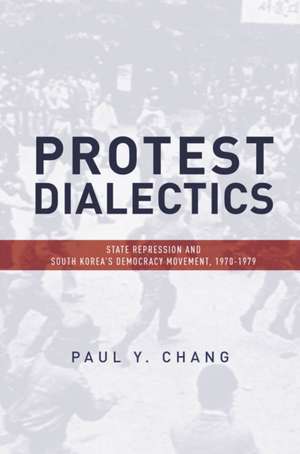Protest Dialectics – State Repression and South Korea`s Democracy Movement, 1970–1979
Autor Paul Changen Limba Engleză Paperback – 4 mar 2019
Protest Dialectics journeys back to 1970s South Korea and provides readers with an in-depth understanding of the numerous events in the 1970s that laid the groundwork for the 1980s democracy movement and the formation of civil society today. Chang shows how the narrative of the 1970s as democracy's dark age obfuscates the important material and discursive developments that became the foundations for the movement in the 1980s which, in turn, paved the way for the institutionalization of civil society after transition in 1987. To correct for these oversights in the literature and to better understand the origins of South Korea's vibrant social movement sector this book presents a comprehensive analysis of the emergence and evolution of the democracy movement in the 1970s.
Preț: 249.35 lei
Nou
47.72€ • 49.54$ • 39.79£
Carte tipărită la comandă
Livrare economică 22 martie-05 aprilie
Specificații
ISBN-10: 1503610128
Pagini: 312
Dimensiuni: 154 x 229 x 23 mm
Greutate: 0.59 kg
Editura: MK – Stanford University Press
Cuprins
The introductory chapter lays out the empirical and theoretical justifications for the study. It focuses on the long historical process of democratization in South Korea. The introduction also discusses limitations of the sociological literature on the relationship between repression and mobilization and argues that the present study offers a more nuanced understanding of social movement development in highly repressive contexts. It ends with a summary of the empirical chapters.
Chapter 1 tracks the transformation of President Park Chung Hee's leadership as he shifted from ruling within the parameters of a democratic system to establishing a formal authoritarian structure in 1972. The chapter discusses his pursuit of national security and economic development that led to two important policy decisions in the 1960s: Korea's participation in the Vietnam War and normalization of relations with Japan. Intent on pushing through his policies, Park Chung Hee reverted to using the military to put down student demonstrations, which reflected his increasing reliance on coercive tactics to silence criticisms of his policies. This chapter shows how this authoritarian tendency culminated in the Yusin Constitution in 1972.
Chapter 2 discusses the repressive structures that undergirded Park's dictatorship including the military and the Korean Central Intelligence Agency. In addition, based on a fairly nuanced and evolving repression strategy, Park consolidated the authoritarian system by enacting additional political control laws that allowed him to ignore basic rights and bypass habeas corpus codified in his own Yusin Constitution. The promulgation of presidential Emergency Decrees, along with the National Security Law and the Anti-Communist Law, reflected a greater capacity for structural repression. This chapter presents a temporal analysis of aggregate protest data that shows that increasing state repression had a profoundly negative impact on the ability of dissidents to stage public protests.
Chapter 3 explains how students, based on a proud history of political engagement, made multiple attempts to organize a nationwide movement against Park Chung Hee's government. The state, consequently, targeted the student movement in recognition of the powerful potential of students to galvanize social change. Increasing state repression was fueled by Park's determination to not let large student protests develop into the kind of "revolution" that brought down Syngman Rhee's government in 1960. This chapter shows that the consequences of repression were dire for students as the arrests and incarceration of thousands of student protestors led to the rapid demobilization of their movement at two critical junctures in 1971 and 1974.
Chapter 4 discusses the emergence of Christian activists who replaced students as central leaders of the movement after 1975. The participation of Christians in anti-government protests was critical to the survival of the democracy movement and for various reasons discussed in the chapter¿including symbolic power, organizational resources, and international connections¿the state was less effective at repressing them than other secular groups.
Chapter 5 explores how and why journalists and lawyers became key contributors to the democracy movement in the latter part of the 1970s. While each addressed different aspects of Park Chung Hee's authoritarian government, both groups came to the fore of the movement as the severity of state repression reached new heights. The chapter shows that key state repression strategies¿the advertisement repression of newspapers in 1974, the demobilization of students in 1974, the People's Revolutionary Party case in 1975¿motivated the politicization of new movement actors.
Chapter 6 argues that state repression unintentionally motivated the development of protest strategies and the movement's ideology. Because different groups relied on tactics that were specific to their groups' cultural norms, the demobilization of the student movement and the entry of new movement actors altered the overall character of the movement. Similarly, while the initial goals of the movement in the early 1970s revolved around democratic and economic reforms, new actors further diversified the issues that were raised in anti-government protests including adopting the human rights discourse.
Chapter 7 explores an additional unintended consequence of state repression. The diversification of movement actors provided the opportunity to create alliances and coalitions which in turn strengthened the solidarity of the movement. Movement solidarity, the chapter argues, was primarily driven by the repression strategies the state employed against dissenting groups. The impact of outgroup contention on ingroup solidarity is evident in the formation of loose-based alliances between diverse sectors of the democracy movement. These informal alliances, in turn, led to formal coalitional organizations that brought together Christians, oppositional politicians, intellectuals, and students.
The concluding chapter broadens the analytic lens by discussing the legacy of the 1970s democracy movement for South Korea's democratization. Although the Yusin system ended with Park Chung Hee's death in 1979, social movements active during Park's reign continued to have consequences for the democracy movement in the 1980s. This chapter shows how the movement in the 1980s inherited from the 1970s several important pillars of mobilization, including a generation of leaders who came of age during the Yusin period, organizational models, and master symbols defining the movement's ideology.
